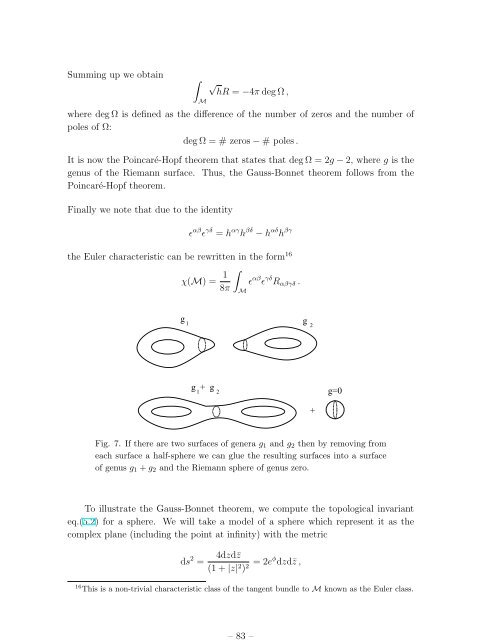Lectures on String Theory
Lectures on String Theory
Lectures on String Theory
You also want an ePaper? Increase the reach of your titles
YUMPU automatically turns print PDFs into web optimized ePapers that Google loves.
– 83 –<br />
Summing up we obtain<br />
∫<br />
√<br />
hR = −4π deg Ω ,<br />
M<br />
where deg Ω is defined as the difference of the number of zeros and the number of<br />
poles of Ω:<br />
deg Ω = # zeros − # poles .<br />
It is now the Poincaré-Hopf theorem that states that deg Ω = 2g − 2, where g is the<br />
genus of the Riemann surface. Thus, the Gauss-B<strong>on</strong>net theorem follows from the<br />
Poincaré-Hopf theorem.<br />
Finally we note that due to the identity<br />
ɛ αβ ɛ γδ = h αγ h βδ − h αδ h βγ<br />
the Euler characteristic can be rewritten in the form 16<br />
χ(M) = 1<br />
8π<br />
∫<br />
M<br />
ɛ αβ ɛ γδ R αβγδ .<br />
g<br />
1 2<br />
g<br />
g + g<br />
1<br />
2<br />
g=0<br />
+<br />
Fig. 7. If there are two surfaces of genera g 1 and g 2 then by removing from<br />
each surface a half-sphere we can glue the resulting surfaces into a surface<br />
of genus g 1 + g 2 and the Riemann sphere of genus zero.<br />
To illustrate the Gauss-B<strong>on</strong>net theorem, we compute the topological invariant<br />
eq.(5.2) for a sphere. We will take a model of a sphere which represent it as the<br />
complex plane (including the point at infinity) with the metric<br />
ds 2 =<br />
4dzd¯z<br />
(1 + |z| 2 ) 2 = 2eφ dzd¯z ,<br />
16 This is a n<strong>on</strong>-trivial characteristic class of the tangent bundle to M known as the Euler class.

















